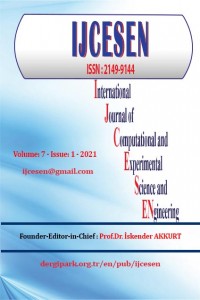Erratum
Year 2021,
Volume: 7 Issue: 1, 45 - 45, 31.03.2021
Abstract
References
- [1] Kunnath Aven, N., Weaver, J., Loghry, R., & Tang, T. (2013). Long-Term Dynamic Flow Testing of Proppants and Effect of Coatings. Presented at the SPE European Formation Damage Conference & Exhibition, Society of Petroleum Engineers. https://doi.org/10.2118/165118-MS.
- [2] Lacy, L. L., Rickards, A. R., & Bilden, D. M. (1998). Fracture Width and Embedment Testing in Soft Reservoir Sandstone. SPE Drilling & Completion, 13(01), 25–29. https://doi.org/10.2118/36421-PA.
- [3] Vlis, V. D., C, A., Haafkens, R., Schipper, B. A., & Visser, W. (1975). Criteria For Proppant Placement and Fracture Conductivity. Presented at the Fall Meeting of the Society of Petroleum Engineers of AIME, Society of Petroleum Engineers. https://doi.org/10.2118/5637-MS.
- [4] Chao, L., Zhihong, Z., Jianchun, G., & Shengchuan, Z. (2016). Experimental study on conductivity decline with proppant embedment in tight oil reservoir. Petroleum Geology and Recovery Efficiency, 23(4), 122–126.
- [5] Wen, Q., Zhang, S., Wang, L., Liu, Y., & Li, X. (2007). The effect of proppant embedment upon the long-term conductivity of fractures. Journal of Petroleum Science and Engineering, 55(3), 221–227. https://doi.org/10.1016/j.petrol.2006.08.010.
- [6] Szymanska, J., Wisniewski, P., Wawulska-Marek, P., Malek, M., & Mizera, J. (2016). Selecting key parameters of the green pellets and lightweight ceramic proppants for enhanced shale gas exploitation. In F. Iacoviello, L. Reis, M. Fonte, M. Freitas, & V. Infante (Eds.), Xv Portuguese Conference on Fracture, Pcf 2016 (Vol. 1, pp. 297–304). Amsterdam: Elsevier Science Bv.
- [7] Duenckel, R., Moore, N., O’Connell, L., Abney, K., Drylie, S., & Chen, F. (2016). The Science of Proppant Conductivity Testing- Lessons Learned and Best Practices. Presented at the SPE Hydraulic Fracturing Technology Conference, Society of Petroleum Engineers. https://doi.org/10.2118/179125-MS.
- [8] API RP 61 - Recommended Practices for Evaluating Short Term Proppant Pack Conductivity | Engineering360. (n.d.). Retrieved June 18, 2017, from http://standards.globalspec.com/std/61555/api-rp-61.
- [9] API RP 27 - RECOMMENDED PRACTICE FOR DETERMINING PERMEABILITY OF POROUS MEDIA THIRD EDITION (R 1956) (WITHDRAWN) | Engineering360. (n.d.). Retrieved June 18, 2017, from http://standards.globalspec.com/std/554507/api-rp-27.
- [10] Palisch, T. T., Duenckel, R., Chapman, M. A., Woolfolk, S., & Vincent, M. (2010). How To Use and Misuse Proppant Crush Tests: Exposing the Top 10 Myths. SPE Production & Operations, 25(03), 345–354. https://doi.org/10.2118/119242-PA.
Erratum to “Experimental Study on Fracture Conductivity in Hydraulic Fracturing” [IJCESEN 6-1(2020)19-22 doi: 10.22399/ijcesen.570108]
Abstract
This paper represent correction of some information previously published paper (IJCESEN 6-1(2020)19-22 doi: 10.22399/ijcesen.570108). The details are given below.
Keywords
References
- [1] Kunnath Aven, N., Weaver, J., Loghry, R., & Tang, T. (2013). Long-Term Dynamic Flow Testing of Proppants and Effect of Coatings. Presented at the SPE European Formation Damage Conference & Exhibition, Society of Petroleum Engineers. https://doi.org/10.2118/165118-MS.
- [2] Lacy, L. L., Rickards, A. R., & Bilden, D. M. (1998). Fracture Width and Embedment Testing in Soft Reservoir Sandstone. SPE Drilling & Completion, 13(01), 25–29. https://doi.org/10.2118/36421-PA.
- [3] Vlis, V. D., C, A., Haafkens, R., Schipper, B. A., & Visser, W. (1975). Criteria For Proppant Placement and Fracture Conductivity. Presented at the Fall Meeting of the Society of Petroleum Engineers of AIME, Society of Petroleum Engineers. https://doi.org/10.2118/5637-MS.
- [4] Chao, L., Zhihong, Z., Jianchun, G., & Shengchuan, Z. (2016). Experimental study on conductivity decline with proppant embedment in tight oil reservoir. Petroleum Geology and Recovery Efficiency, 23(4), 122–126.
- [5] Wen, Q., Zhang, S., Wang, L., Liu, Y., & Li, X. (2007). The effect of proppant embedment upon the long-term conductivity of fractures. Journal of Petroleum Science and Engineering, 55(3), 221–227. https://doi.org/10.1016/j.petrol.2006.08.010.
- [6] Szymanska, J., Wisniewski, P., Wawulska-Marek, P., Malek, M., & Mizera, J. (2016). Selecting key parameters of the green pellets and lightweight ceramic proppants for enhanced shale gas exploitation. In F. Iacoviello, L. Reis, M. Fonte, M. Freitas, & V. Infante (Eds.), Xv Portuguese Conference on Fracture, Pcf 2016 (Vol. 1, pp. 297–304). Amsterdam: Elsevier Science Bv.
- [7] Duenckel, R., Moore, N., O’Connell, L., Abney, K., Drylie, S., & Chen, F. (2016). The Science of Proppant Conductivity Testing- Lessons Learned and Best Practices. Presented at the SPE Hydraulic Fracturing Technology Conference, Society of Petroleum Engineers. https://doi.org/10.2118/179125-MS.
- [8] API RP 61 - Recommended Practices for Evaluating Short Term Proppant Pack Conductivity | Engineering360. (n.d.). Retrieved June 18, 2017, from http://standards.globalspec.com/std/61555/api-rp-61.
- [9] API RP 27 - RECOMMENDED PRACTICE FOR DETERMINING PERMEABILITY OF POROUS MEDIA THIRD EDITION (R 1956) (WITHDRAWN) | Engineering360. (n.d.). Retrieved June 18, 2017, from http://standards.globalspec.com/std/554507/api-rp-27.
- [10] Palisch, T. T., Duenckel, R., Chapman, M. A., Woolfolk, S., & Vincent, M. (2010). How To Use and Misuse Proppant Crush Tests: Exposing the Top 10 Myths. SPE Production & Operations, 25(03), 345–354. https://doi.org/10.2118/119242-PA.
There are 10 citations in total.
Details
| Primary Language | English |
|---|---|
| Subjects | Engineering |
| Journal Section | Erratum |
| Authors | |
| Publication Date | March 31, 2021 |
| Submission Date | February 19, 2021 |
| Acceptance Date | March 31, 2021 |
| Published in Issue | Year 2021 Volume: 7 Issue: 1 |

